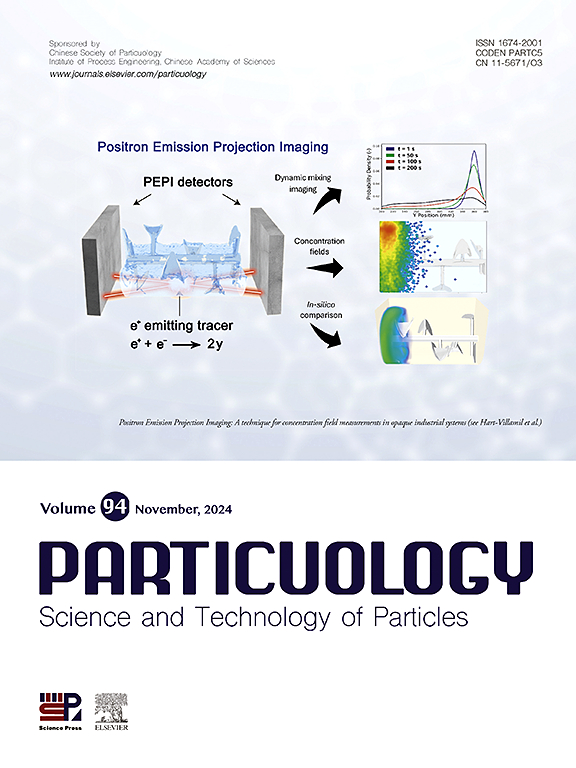Drawdown and suspension of corn straw in the non-Newtonian fluid in stirred tank
IF 4.3
2区 材料科学
Q2 ENGINEERING, CHEMICAL
引用次数: 0
Abstract
Due to the low density and hydrophobicity, the corn straw (CS) particles tend to float on the liquid surface in the anaerobic digester, deteriorating the bioconversion efficiency and process stability. Although the mechanical mixing is widely used in digesters, the drawdown and suspension of CS in the non-Newtonian slurry have not been sufficiently studied. This paper investigated the effect of particle size, liquid viscosity, solid phase mass fraction, impeller type and off-bottom distance on the just-drawdown rotational speed (Njd), complete drawdown rotational speed (Ncd) and cloud depth (CD) of dry and wet straw particles in the stirred tank. The results showed that the distribution of dry and wet straw in the stirred tank significantly differed due to differences in density and wettability. The models built by dimensional analysis and machine learning were suitable for accurate predictions of specific variables. Based on the model analysis, the Njd of dry straw was mainly affected by the liquid viscosity, impeller type and off-bottom distance, as these factors determined the flow field of liquid phase for its drawdown. Njd of wet straw was related to the liquid viscosity and Ncd was influenced by impeller off-bottom distance. The CD of dry and wet straw particles were both affected by rotational speed, impeller type, and liquid viscosity, which were related to the mean flow and turbulence intensity in the tank. The results provide valuable references for the design and operation of mixing configurations for low-density feedstocks in the anaerobic digester.

玉米秸秆在搅拌槽内非牛顿流体中的沉降和悬浮
玉米秸秆颗粒由于其低密度和疏水性,容易在厌氧消化池液面漂浮,使生物转化效率和工艺稳定性下降。虽然机械搅拌在蒸煮器中得到了广泛的应用,但CS在非牛顿料浆中的沉降和悬浮尚未得到充分的研究。本文研究了粒径、液体粘度、固相质量分数、叶轮类型和离底距离对搅拌槽内干、湿秸秆颗粒刚降转速(Njd)、完全降转速(Ncd)和云深(CD)的影响。结果表明,由于密度和润湿性的差异,干秸秆和湿秸秆在搅拌槽中的分布存在显著差异。通过量纲分析和机器学习建立的模型适合于对特定变量的准确预测。通过模型分析,干秸秆的Njd主要受液体粘度、叶轮类型和离底距离的影响,这些因素决定了液相的流场,使其下降。湿秸秆的Njd与液体粘度有关,Ncd受叶轮离底距离的影响。干湿秸秆颗粒的CD均受转速、叶轮类型和液体粘度的影响,而这又与槽内的平均流量和湍流强度有关。研究结果为厌氧消化器低密度原料混合配置的设计和运行提供了有价值的参考。
本文章由计算机程序翻译,如有差异,请以英文原文为准。
求助全文
约1分钟内获得全文
求助全文
来源期刊

Particuology
工程技术-材料科学:综合
CiteScore
6.70
自引率
2.90%
发文量
1730
审稿时长
32 days
期刊介绍:
The word ‘particuology’ was coined to parallel the discipline for the science and technology of particles.
Particuology is an interdisciplinary journal that publishes frontier research articles and critical reviews on the discovery, formulation and engineering of particulate materials, processes and systems. It especially welcomes contributions utilising advanced theoretical, modelling and measurement methods to enable the discovery and creation of new particulate materials, and the manufacturing of functional particulate-based products, such as sensors.
Papers are handled by Thematic Editors who oversee contributions from specific subject fields. These fields are classified into: Particle Synthesis and Modification; Particle Characterization and Measurement; Granular Systems and Bulk Solids Technology; Fluidization and Particle-Fluid Systems; Aerosols; and Applications of Particle Technology.
Key topics concerning the creation and processing of particulates include:
-Modelling and simulation of particle formation, collective behaviour of particles and systems for particle production over a broad spectrum of length scales
-Mining of experimental data for particle synthesis and surface properties to facilitate the creation of new materials and processes
-Particle design and preparation including controlled response and sensing functionalities in formation, delivery systems and biological systems, etc.
-Experimental and computational methods for visualization and analysis of particulate system.
These topics are broadly relevant to the production of materials, pharmaceuticals and food, and to the conversion of energy resources to fuels and protection of the environment.
 求助内容:
求助内容: 应助结果提醒方式:
应助结果提醒方式:


